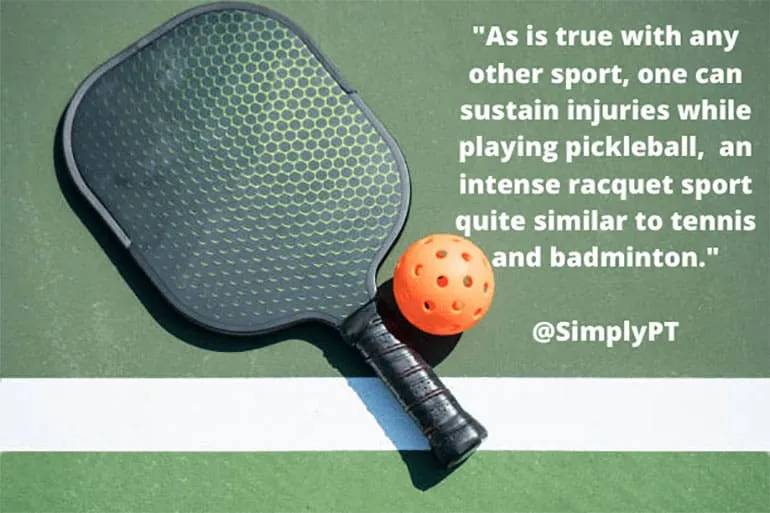We asked our college intern, Leann Coronado, to help collaborate with us on a blog for Simply Physio. Leann has been shadowing with us over the summer and is a student at Appalachian State University, she plans to apply to physical therapy school in the near future.
Can I get hurt playing pickleball?
As is true with any other sport, one can sustain injuries while playing pickleball, an intense racquet sport quite similar to tennis and badminton. It is fast paced, and thus players must execute quick pivots as they change directions in moving to hit the ball.
What are the most common types of injuries in pickleball?
Similar to tennis and any other racquet sport, the most common injuries in pickleball involve the ankles and wrists.
The most common and well-known lower extremity injuries in pickleball are ankle strains caused by sudden turns. Pickleball involves immediate changes of direction from one side of the court to the other. Ankle strains can range from the injured person barely being able to put weight on the injured area to more seriously impaired movements of the foot.
Similar to an ankle strain, another common injury that can occur while playing pickleball is an Achilles tendon strain. This injury involves the band of tissue along the backside of the leg from the calcaneus (ankle) up to the calf. This strain arises from increased overuse in intensity and “stop-and-go action.” When playing pickleball, players wait for the ball to come back to their side of the court and must maneuver towards the direction the ball is going (“stop-and-go action”). When this strain takes place, it often is quite immediately noticeable, because one finds it difficult to place weight on the foot.
Further, upper body injuries, including wrist and shoulder strains, can occur in the sport of pickleball because returning the ball over the net demands players to use their upper body, neck, and even their back.
Because pickleball participants constantly must pace back and forth on the court, trips and falls are inevitable. When they do fall, they instinctively tend to stretch out their arms to protect themselves. Unfortunately, this natural response can cause an overstretching or slight tearing of the ligaments in the wrist. One’s wrists can swell and be difficult to rotate. However, recovery from mild strains are typically short and can begin to heal within a few days.
A shoulder strain is common in pickleball as well. Even though in pickleball, players serve and volley with paddles below their shoulders, the repetitive use of force can produce rotator cuff inflammation or tendonitis.
Traditional recovery methods involved “RICE” or Rest, Ice, Compression, and Elevation.
The RICE principle is actually outdated and not as effective as other strategies. Our current understanding of injury recovery is better realized by implementing the “MEAT” method.
Even if players are injured while playing pickleball, they should not worry; instead, they simply should remember the rules of the MEAT acronym:
- Movement
- Exercise
- Analgesics
- Treatment
M.E.A.T. starts with movement. This theory argues that a person should begin movement in the injured area as soon as possible. Relative Rest can be a necessary step (for a few days or sometimes a bit longer). M.E.A.T. suggests finding a routine of gentle movement without exceeding pain tolerance during this relative rest period. These light movements can stimulate healing as tissues recover through a gradual increase in healthy stress and strain.
Movement helps bring oxygen rich blood to the area to assist with healing and can also help flush out tissue “debris”.
A gradual increase in movement will then allow you to begin a light and or targeted exercise routine to further support the injured area. You won’t be able to return fully back to pickleball at this point, but maybe you can swim, bike, or even a walking program could be a good next step. Just remember, don’t push through pain at any point while you are still recovering.
Analgesics are used as needed to control pain. Not all pain is bad though. Pain’s purpose is to protect us from developing a greater injury. So use analgesics as needed recognizing that pain can be a helpful guide informing you of when you may be trying too hard to recover.
The final step of this process is treatment, the solution to long-term, complete healing. Patients should work with a professional, like a physical therapist or appropriate physician, for a long-term plan. Recovering from an injury is the 1st step, but even better is to work with a movement expert in figuring out what needs to happen to prevent this from occurring again. When you only treat the injured area then your long term results will be impacted. Pickleball is a full body sport so your recovery program must also consider movement of the whole body if you are looking for optimal recovery and optimal results on the court.
Pickleball is rising in popularity because it is fun and enjoyable; if you haven’t tried it, give it a shot!
If you’re looking for more tips like these for recovering from a pickleball injury- then be sure to request our guide:
Leann wanted to share her thoughts on her experience shadowing us at Simply Physio:
“I had the amazing opportunity to observe the outstanding work done at Simply Physio (following COVID-19 guidelines). I was able to shadow Dr. Sarah Fields throughout this time and observe how she changes patients’ lives. The time I spent there has widened my perspective about physical therapy, especially the way it can help patients execute their everyday activities without taking medications.”Enter your text here…
Leann- it has been a pleasure having you with us this summer. Keep your head in the books and we can’t wait to hear about your progress with your studies as you get further into the field of physical therapy!



